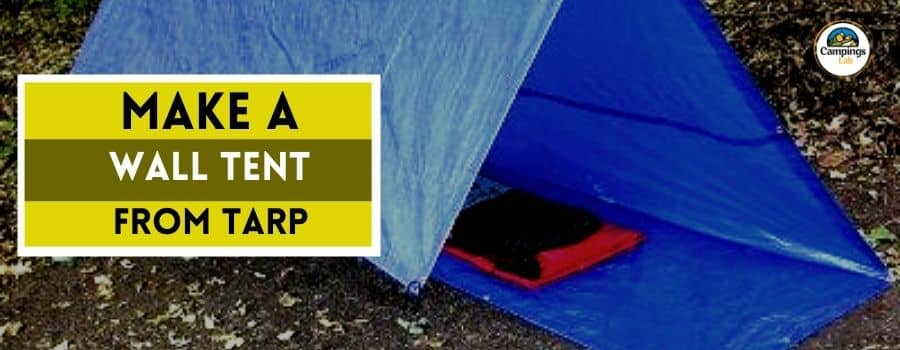Last Spring, when my friends and I went camping, one of the tent poles broke and none of us had any idea about making tent poles. Have you been in the same situation and wondered How To Make Your Own Tent Poles? If that is the case, then you are at the right place.
Whether it is outdoor for camping or to make an indoor fort, tents can fulfill the purpose easily. With the slightest ease, DIY tent poles can be a life-saver. You will find everything you need to know about tent poles and related components right here.
Page Contents
Different Types Of Tent Poles
Poles are often overlooked when considering a tent. But it is one of the most crucial parts of a tent. Tent poles made of various materials can be found in the market.
While some may be more bendable, another will provide more durability and so it is important to have this knowledge to make your own tent pole.
Before Jump Into How To Make Your Own Tent Poles (DIY Tent Poles Tips)
Tent poles are mainly of two sorts. Poles with inserts and poles without inserts. Poles that do have inserts (also called sleeve) is normally stuck together with either glue or bolts inside either hollow end.
Before you set out to make your own pole, the best practice and approach will be to plan out how many sections and of what sort you will require for your tent. For example, a pole with 4 sections can be made with 3 sections with insert and 1 section without.
You will also need to know the diameter of the poles that you will be making. Mismatching pole diameters will drastically reduce structural integrity.
DIY Pole With Insert
To make tent poles, first, you will need to get yourself stainless steel conduits. These conduits are hollow inside, lightweight, and fairly cheap for the purpose. As the poles will be replacing previous ones, you will mark them slightly longer than the original pole and use a saw tool to cut it.
Depending on which poles you had previously, you might need to drill holes in the conduit for inserting pins, etc. You will also be needing sleeves for your poles. For the sleeves, get conduits that are slightly bigger than your initial ones to slide over the smaller poles.
If you intend to make one-piece poles, then you have completed your homemade tent poles. If not, then you will need to do some more drilling and cutting.
Center the sleeve over your newly made pole while making sure it does not cover any holes that were drilled. Now, clamp the sleeve and pole tightly while marking at 3-inch length from both ends.
You will need to drill holes into the conduits to bolt them in place. Pick a drill bit that is about the size of the bolts you will be using and drill through both the pole and sleeve.
To keep the arrangement in place, insert a bolt and nut through the hole. Disassemble and rearrange it. Only a set of holes will match which you will need to secure by putting in a bolt, washer, and nut.
Now you can put in the other half of the pole which you will cut in half right between the holes drilled for the sleeves.
You are done making your own tent poles with the least effort and cost. You can trim the bolts so that they do not stick out. Fiberglass tent pole end tips can also be placed at the end of the poles.
DIY Pole With Shock Cord
Poles with shock cords are widely used. To make your poles with a shock cord, you will need either hollow aluminum or carbon fiber, whichever material you prefer.
You can use a saw or pipe cutter to trim the pole according to your desired pole length. Now select your desired end tip and attach it to one end of the shock cord by making a knot and gently push it through the poles.
After passing through the last pole, attach the other end tip to the shock cord and push it into the hollow end. You can now test the tension. It is never advisable to have it too tense and tight. The shock cord can be tied tighter or looser to achieve the desired tension.
DIY Tent Pole Replacement
A broken tent pole needs to be replaced as early as possible as the broken part weakens the structure and might cause the tent to collapse. Tent pole replacement is an easy task.
Following these steps, you can easily replace a broken pole.
- First, you will have to unscrew one tip of your pole.
- After unscrewing the end, you can pull out the hook to remove it from the elastic
- If you pull both sides of the knot simultaneously, the knot will dissipate.
- Now you can safely remove the poles one by one till you reach the broken pole. Remember to hold the other end of the elastic while removing a pole.
- Easily insert the elastic cord into the new replacement pole till you reach the last pole.
- Finally, tie a small knot at the end of the elastic which will hold the small screw from before and it can be placed back in its place.
Different Tent Pole
Tent poles are made of various materials but there are four that are most prominent. The durability and bendability depend on the material used.
Fiberglass Tent Poles
Fiberglass tent poles are among the most popular choices as they are inexpensive compared to other poles. While these poles offer increased bendability, pitching larger tents is near impossible as the slightest wind can deform the poles with the weight of the fabric. Again, the cheap cost of great support cannot be disregarded.
Steel Tent Poles
Poles made of steel are much sturdier than the fiberglass counterparts. As the steel build is more resistant to turbulent winds. But the added durability comes with a weight penalty which makes moving around troublesome because of heavy lifting.
Aluminum Alloy Tent Poles
Aluminum alloy poles are heavy duty poles capable of handling increased weights with ease. They are quite rigid. Aluminum alloy poles can be found in different grades which is easily identifiable with the price tag but generally, they tend to be quite expensive.
Carbon Fiber Tent Poles
These sleek looking ultralight poles are made from top-quality carbon fiber which provides excellent support. An adjustable carbon fiber tent pole is important to pitch tents in different shapes as per need and space restrictions. The only noticeable downside is the high price tags.
Tent Pole Materials
Tent pole parts are about the same for all pole types. Exceptions can be a pole with a shock cord and one without a shock cord.
The shock cord is one of the most crucial parts as it is holding the poles together. The general rule is to use a shock cord equal to the length of the pole which results in enough tension when the knots are tied.
Pole end tips are another crucial part. The type of end tip used varies on what pole type is being used. Poles with a shock cord will require tie-off end tips while poles without a shock cord are much more compatible with compression fitting end tips.
If you are ever left with a broken pole, unable to find replacements, after reading this, you will know what to do. Choose your desired tent poles and set out to go camping. You will know exactly what to choose and go for.
Knowing how to make tent poles is handy knowledge to have. You can never guess when you might need to make a pole either for a tent or for any other purpose.
No broken poles will stop you from pitching tents anymore. So, what are you waiting for? Cut some conduits, grab a shock cord and make your first tent pole today!





Leave a Reply